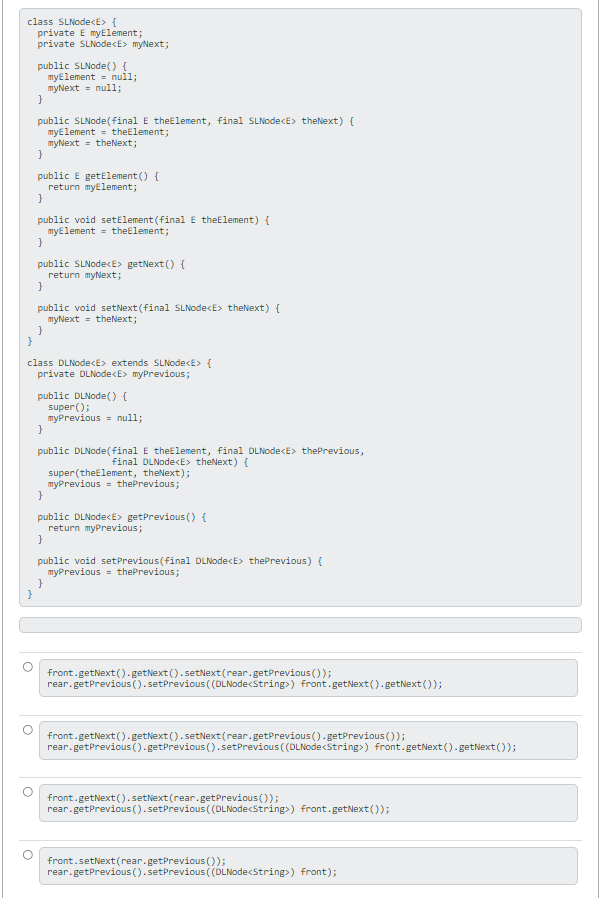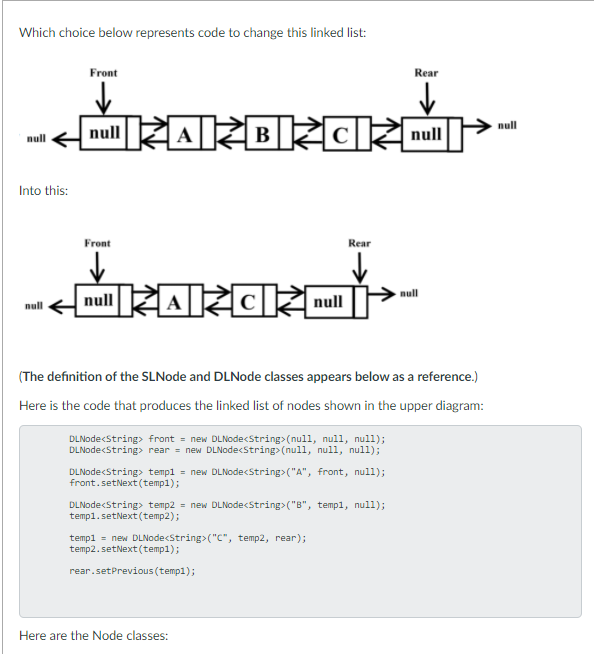Which choice below represents code to change this linked list: Front Rear null null B null null Into this: Front Rear "RARCRI null null null null
Which choice below represents code to change this linked list: Front Rear null null B null null Into this: Front Rear "RARCRI null null null null
Database System Concepts
7th Edition
ISBN:9780078022159
Author:Abraham Silberschatz Professor, Henry F. Korth, S. Sudarshan
Publisher:Abraham Silberschatz Professor, Henry F. Korth, S. Sudarshan
Chapter1: Introduction
Section: Chapter Questions
Problem 1PE
Related questions
Question
Computer science question

Transcribed Image Text:class SLNode<E> {
private E myElement;
private SLNodecE> myNext;
public SLNode() {
myElement = null;
myNext = null;
public SLNode( final E theElement, final SLNodecE> theNext) {
myElement = theElement;
myNext = theNext;
public E getElement () {
return myElement;
public void setElement (final E theElement) {
myElement = theElement;
public SLNodecE> getNext () {
return myNext;
public void setNext (final SLNodecE> theNext) {
myNext = theNext;
}
class DLNodecE> extends SLNodecE> {
private DLNode<E> myPrevious;
public DLNode() {
super();
myPrevious = null;
public DLNode(final E theElement, final DLNode<E> thePrevious,
final DLNode<E> theNext) {
super(theElement, theNext);
myPrevious = thePrevious;
public DLNodecE> getPrevious () {
return myPrevious;
public void setPrevious(final DLNode<E> thePrevious) {
myPrevious = thePrevious;
}
}
front.getNext ()- getNext ().setNext(rear.getPrevious ());
rear.getPrevious ().setPrevious (DLNodecString>) front.getNext().getNext ());
front.getNext().getNext ().setNext(rear.getPrevious ().getPrevious();
rear.getPrevious ().getPrevious ().setPrevious ( (DLNode<String>) front.getNext (). getNext());
front.getNext ().setNext (rear.getPrevious ());
rear.getPrevious ((). setPrevious( (DLNodecstring>) front.getNext ());
front.setNext (rear.getPrevious ());
rear.getPrevious (). setPrevious ( (DLNodecString>) front);

Transcribed Image Text:Which choice below represents code to change this linked list:
Front
Rear
RARBZC a
null
null
null
Into this:
Front
Rear
nullRARCZE
null
null
(The definition of the SLNode and DLNode classes appears below as a reference.)
Here is the code that produces the linked list of nodes shown in the upper diagram:
DLNode<String> front = new DLNode<String> (nul1, null, null);
DLNodecString> rear = new DLNodecString> (null, null, null);
DLNode<String> templ = new DLNode<String>("A", front, null);
front.setNext (temp1);
DLNodecString> temp2 = new DLNode<String> ("B", templ, null);
templ.setNext (temp2);
templ = new DLNodecString> ("C", temp2, rear);
temp2.setNext (temp1);
rear.setPrevious (templ);
Here are the Node classes:
Expert Solution
This question has been solved!
Explore an expertly crafted, step-by-step solution for a thorough understanding of key concepts.
Step by step
Solved in 2 steps

Knowledge Booster
Learn more about
Need a deep-dive on the concept behind this application? Look no further. Learn more about this topic, computer-science and related others by exploring similar questions and additional content below.Recommended textbooks for you

Database System Concepts
Computer Science
ISBN:
9780078022159
Author:
Abraham Silberschatz Professor, Henry F. Korth, S. Sudarshan
Publisher:
McGraw-Hill Education

Starting Out with Python (4th Edition)
Computer Science
ISBN:
9780134444321
Author:
Tony Gaddis
Publisher:
PEARSON

Digital Fundamentals (11th Edition)
Computer Science
ISBN:
9780132737968
Author:
Thomas L. Floyd
Publisher:
PEARSON

Database System Concepts
Computer Science
ISBN:
9780078022159
Author:
Abraham Silberschatz Professor, Henry F. Korth, S. Sudarshan
Publisher:
McGraw-Hill Education

Starting Out with Python (4th Edition)
Computer Science
ISBN:
9780134444321
Author:
Tony Gaddis
Publisher:
PEARSON

Digital Fundamentals (11th Edition)
Computer Science
ISBN:
9780132737968
Author:
Thomas L. Floyd
Publisher:
PEARSON

C How to Program (8th Edition)
Computer Science
ISBN:
9780133976892
Author:
Paul J. Deitel, Harvey Deitel
Publisher:
PEARSON

Database Systems: Design, Implementation, & Manag…
Computer Science
ISBN:
9781337627900
Author:
Carlos Coronel, Steven Morris
Publisher:
Cengage Learning

Programmable Logic Controllers
Computer Science
ISBN:
9780073373843
Author:
Frank D. Petruzella
Publisher:
McGraw-Hill Education